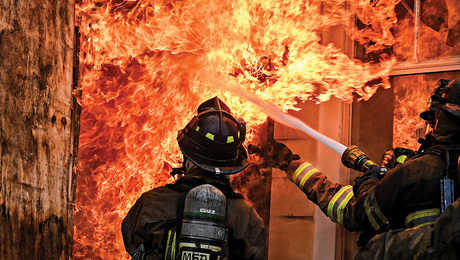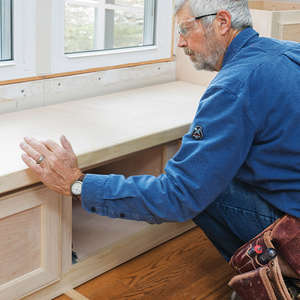Hi,
I plan on refurbishing a part of my deck, and I have a simple (I think) question on selecting the right lumber for my deck structure. Some background: the deck is a second story cantilevered deck, about 40 feet wide by 6 feet deep. The joists are 2×10, and are simply extended floor joists from inside the house, so they are Doug Fir. Obviously I am not replacing these joists. However, I plan to replace the stair stringers that connect the deck to the ground level, add some blocking, and a rim joist. Also, I will build a tiny (about 3′ x 7′) deck nearby, which will be about 2 feet off the ground, mounted on two posts and a ledger board anchored to the house.
With this background, my question is what lumber should I use for all these pieces (ledgers, posts, beams, blocking, stringers)? Does all of it need to be pressure treated lumber, as some of my books imply? Or does that apply only to those elements that come to within a few inches of the ground (posts, stringers)? Seems kind of silly to be using p.t. lumber for blocking between joists that are “plain” doug fir, and are 15 feet off the ground… Any suggestions?
Also, if I use “plain” doug fir, is solid color stain a good choice for finishing? Finally, do I need to find galvanized joist hanger brackets, or are the “regular” ones fairly weather resistant? I live in Southern California, so weather is failry benign here.
The decking itself will be some sort of composite, so I’m not worried about that.
Thanks in advance!
Leon



















Replies
Leon- check with your local building department. Codes around here require ALL exterior wood to be treated somehow. My feeling is, why skimp on the framing lumber? I would rather spend a little more to be sure that my projects last. Also, the lumber 15' in the air is still subject to the weather and susceptible to rot and decay.Ive seen quite a bit of damage up high. One last thought -are your cantilevered joists properly flashed? I hope this has helped some.
Thanks for the replies! To answer some of the questions: Yes, the deck is truly cantilevered, so it's really an extension of the house floor framing. As far as flashing of the joists, they are "flashed" with an angled strip of metal that runs along the house; one leg of it covers the top of the joists at the house, and the other leg is placed underneath the stucco wall. I was thinking of adding flashing to the top of every joist, but I am planning to use Deckmaster brackets for the decking, and I think there would be some interferences.
Thanks to your suggestions, I'll be using all p.t. lumber for the small deck, since its underside will be unseen. I am still uncertain about the upper deck, though. It is visible from below, and p.t. lumber, even when painted, is really ugly due to all the perforations. Plus I'm having trouble finding p.t. 2x14's that I need for the stringers. So I'm thinking of using doug fir for stringers and additional blocking, and then protecting the entire structure with something suitable. I'll check out the Termin8 stuff; can it be painted over with a stain after the application?
Does this sound like reasonable thinking?
I was looking at Simpson joist hangers at lunch today, and their catalog claims that they are all galvanized, although by looking at them they seem to be just zinc plated. Do they make separate lines for outdoor use?
All the Simpson stuff is galvanized, except for the black decorative/structural connectors, and those would be special order. Don't mean to nit-pick, but...cantilevered means that there's no support except from the joists that extend into the house. No posts or columns at the outboard ends. Like if you raise your arm to a straight-out level position. Is that what you have?Do it right, or do it twice.
ELCID72,
Don't worry about nitpicking, but yes, I know what "cantilevered" means. I have a degree in mechanical engineering, so even twenty years later, I can probably recite the force/deflection equations for cantilevered and simply supported beams :). These joists are in fact cantilevered, sticking out a full 6 feet. I often considered the idea of increasing the deck's stiffness by adding a beam and posts at the outer end, but that would destroy my back yard, plus would incur about $5,000 of permit fees (I kid you not), so I decided against it. I think I'll paint a bunch of lines on the deck, labeling them as "300lb limit", "200lb limit", etc, as you go outward :).
Is the deck truly cantilevered off the house, or are there support columns? PT lumber will resist a lot of things, and if you plan on staining anyway, then I would suggest you use it as much as possible. Yes, galvanized fasteners and accessories are the way to go. Go to a bolt & fastener store, not HD or Lowes...they have a much better selection and the prices are about half. Regular fasteners rely on the shiny zinc coating for protection. If it gets scratched, that's a start for rust. Galvanized coatings are supposed to be self-healing, up to a point, so they will resist rust and deteriorization much better and longer.
Do it right, or do it twice.
Leon, I'm with shep. I would at least treat the existing joists with something like Termin-8. They make it in green or clear now. The most common cause of dry rot on raised decks that I've seen is not because of the weather. Its usually caused by potted plants that are constantly watered and drain onto the deck.
But, there is a cure for that problem too. Here's how you fix that problem...:
1. Get an old garden hose
2. Drill a hole the size of the garden hose in the base of the pot.
3. Line the pot with plastic, (a contractor garbage bag works pretty good).
4. Make a hole in the garbage bag big enough for the hose to pass through.
5. Insert the hose through the pot and plastic then seal up the plastic around the hose with duct tape.
6. Add your dirt and plant and position the plant where you want it.
7. When your sure its where you want it cut the hose to length so that the drain water runs off, away from the deck.
Probably more info than you wanted but I thought it might be helpful.
leon- Any wood that is structural for the outdoors should be treated.I would use "below ground" for your old joist. Where did you get 14" joists?
I'm curious? If your deck is 15' off the ground, how did your stairs reach the ground without a raised landing? 15' divided by 7.5 = 24 steps.
Most Simpson ties are Hot- dip Galvanized or painted.Stainless is also available.
All their hangers are Galvanized.
Make sure the top side of your existing joists are sound. Usually they are rotted out if they were not treated originally.
Bob
"Rather be a hammer than a nail"
Bob,
Thanks for your comments. What do you mean by "I would use 'below ground' for your old joist"? Is "below ground" some kind of a preservative, like Termin8? Can I then stain over it?
I plan to special order the 2"x14"-12' stringers (not joists); even Home Depot can get those. Is that what you were asking?
Regarding the height, yip, you got it :). The backyard is highly irregular, so while most of the deck hangs about 15' in the air, it's a bit lower on the stair side (or rather the ground is a bit higher), plus there is a big concrete landing with some concrete steps. So there are 12 steps on the wood stairs.
Thanks also for the tip on Simpson hangers, sounds like I can use them without any concerns (but with galvanized nails :) ).
Hopefully the joist tops aren't rotted, I'm pretty much stuck with them, since they go 15 feet into the house :).
Leon
Leon- yes you can paint or stain over "Below Ground". It is green and used to deter rot and bugs on fence posts.
Hopefully the joist tops aren't rotted, I'm pretty much stuck with them, since they go 15 feet into the house :).
I cut those rotted joists off all the time. I then put on a treated ledger, then treated joists beams and posts. In your case it might be better to suspend the overhang with diagonal cables and turnbuckles back to the house.
I plan to special order the 2"x14"-12' stringers (not joists); even Home Depot can get those. Is that what you were asking? Are you sure about that?
I Normally use Pressure treated 3 x12 For My stair stringers and treads. Simpson TA10 stair cleats and 1 1/2" bolts. You can see My stairs on my website.
http://www.pro-dek.com Bob
"Rather be a hammer than a nail"
Bob,
Thanks for the link to your website. You do beautiful work. Unfortunately I'm more or less stuck with the unexciting monstrosity that already extends from my house :). The best I can do is put down some pretty composite decking and add a nice aluminum railing with glass panels.
>I cut those rotted joists off all the time. I then put on a treated ledger, then treated joists beams and posts. In your case it might be better to suspend the overhang with diagonal cables and turnbuckles back to the house.
I hear ya, but My Building and Safety would require so much supporting documentation (and expenses) for something like this, that it wouldn't be worth it to even approach them (been there done that with them before). I've looked at the existing joists pretty carefully today, they look pretty good. Even the paint is holding up well, and I don't see any sign of rot. One of the benefits of living in So Ca where it supposedly never rains...
>>I plan to special order the 2"x14"-12' stringers (not joists); even Home Depot can get those. Is that what you were asking?
>Are you sure about that?
Well, I've done it before when I put a staircase into the basement, so I suppose it can be done again. But from my reading, it's looking like 2x12's would suffice (I plan to use four of them to give good support for the composite decking), so I'll probably go with those. I'll try to find them p.t.'d.
Thanks again,
Leon
Edited 2/22/2003 12:00:20 PM ET by leon
maybe you are lucky because of living in S calif. but I had the same thought as Bob when I read what you wrote, "obviously I won't be replacing them" It is very common that with these old fir joists, they get wet at the point of contact between the top of the joist and the bottom of the deck board. Rot penetrates the joist along the path of the fasteners to create a pocket about the size of a pack of smokes. You can often not find out about it until you remove the decking. Then, slices of rotted lumber lift out along with the deck board.
You should probably take up a sample piece before you define your plans so you know ahead of time what you are dealing with. Select one near the drip line of the roof eave where most problems occour.
Like I said, Bob and I are both in wet climates so we see it worse - enough to expect it on every one. Sometimes we get lucky and the old timer put down a strip of tarpaper to the top of the joist first and it is better than usuall.
.
Excellence is its own reward!
You should probably take up a sample piece before you define your plans so you know ahead of time what you are dealing with. Select one near the drip line of the roof eave where most problems occour.
Piffin, thanks, this is excellent advice. I'll go do some spot checks today. Wish me luck :).
Leon
Edited 2/22/2003 1:30:03 PM ET by leon
Are you "really"sure this deck is cantilevered??????????? :)
>Are you "really"sure this deck is cantilevered??????????? :)
See, this is why this forum is so great! Thanks to you guys, after getting this question asked enough times, I did walk outside this morning, and bumped my head against the beam I don't have and stubbed my toe against the invisible post... I guess they had me fooled all this time, thinking that it was cantilevered... :) :)
BTW, I did inspect the joists, and they all seem very solid. I found one that is a bit questionable, more due to splitting than to rot, and I will put a new one next to it (or in its place). Fortunately, I have access to the floor framing from the basement, so I can add new joists where needed.
I'll make some calls tomorrow to see if I can find 2x14 pt stringers. Would four 2x12-12' stringers be adequate, in case I'm SOL on the 2x14's??
LOL
Are you SURE that you're sure??????
Seems we've got a little missplaced NASA redundacy here.
That detail is something that's hard for some to believe because it is not common or workable in many areas of the country, so you'll just have to forgive. It might be possible too that whoever asked last missed a portion of the dialouge or just came from a discussion with someone who didn't know the terminology builders use and mangled the conversation by misapplying terms..
Excellence is its own reward!
Try your local lumber yards for Timberstrand for the stringers. Its 11 7/8 x 1 1/4 thick and I believe you can get it in 20 or even 24 ft lengths. It is much better than ordering 2x14" material. Finding good 2x12's is hard enough for stringers. It made life much easier for all the framers when the building codes accepted the Timberstrand material for stringers. Since this is an outside application, you will want to seal the material immediately upon installation, though.
There are two, maybe three, levels of treatment for PT lumber. One is rated for ground contact, one is rated for below ground or burial. I think that's right. Anyway, the difference is the amount of CCA or whatever preservative...I think 0.4 is ground contact...it's listed on the label.Do it right, or do it twice.
So is your inspector happy with your 6' deep cantilever of 2x10 fir? I'm starting a house with a similar deck, except 20' long instead of 40', and my engineer wants me to sister 11-7/8" LVL's onto the joists 12' back into the structure in order to support a 6' cantilever.
Well, I don't know what my inspector would say. Or rather, I do, which is why I don't want to ask him. Around here, the inspectors refuse to do any thinking, they will require me to come in with plans approved by an engineer. Getting an engineer around here to approve some plans for a homeowner is similar to pulling teeth (been there done that), and even then I end up finding mistakes in his calcs and asking him to fix them. That's why I mentioned that if I get the city involved, I'll be $5K in the hole before I start.
I think if you read the code book, a 6ft cantilever is just slightly past the limit of 2x10's 1' o.c., so if I start asking questions, I will probably be pushed into the direction of adding posts and beams, or sistering joists all over the place. I am not looking forward to sistering 50 joists :(.
I'll probably check with an architect friend to get a feel for this, but my current thinking is to not touch anything structural (which allows me to not involve the city), and just replace the decking and the railing.
Leon
Well, just talked to the inspector about this. He said that the existing 2x10's 1'o.c. are "more than adequate" for a 6 foot cantilever. Moreover, he said that since I'm only changing the decking material and the railing, they wouldn't require me to do anything with an existing original structure anyway, or to prove its worthiness. So, I guess I'm off the "legal" hook, except that I need to generate some sketches to show the railing attachment scheme.
Why are you being told to reinforce the existing structure in your case? Are you extending the deck or something like that?
Leon
Guess I missed that your framing is on 12" centers.
In my case, it's 16" centers, and new construction. You have a snow load to deal with? What code jurisdiction are you under?